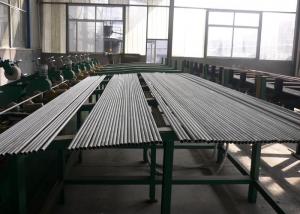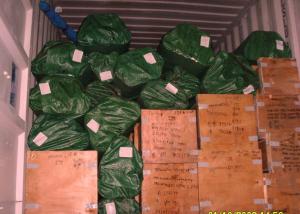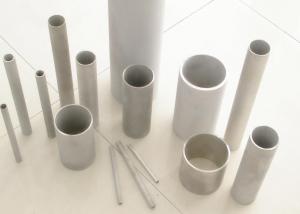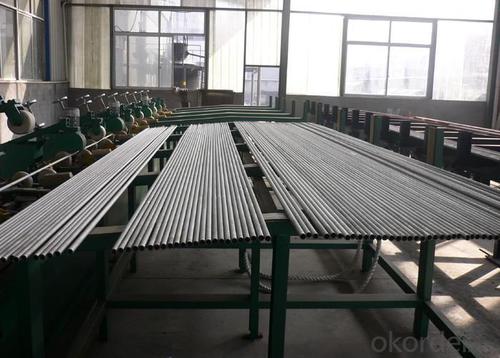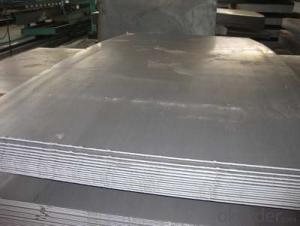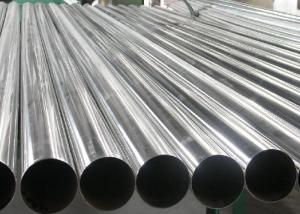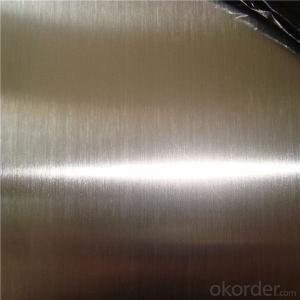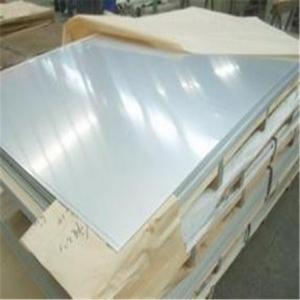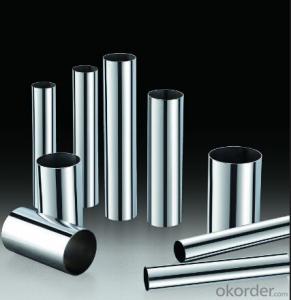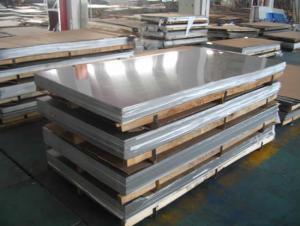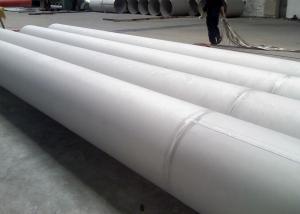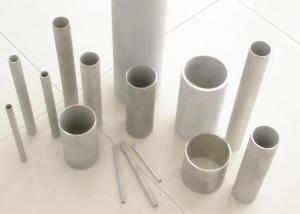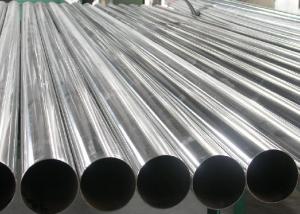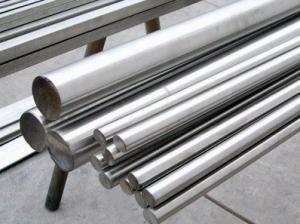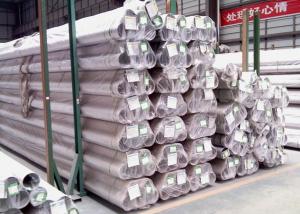316Ti Stainless Steel Seamless Pipe
- Loading Port:
- China Main Port
- Payment Terms:
- TT or LC
- Min Order Qty:
- 5 Tons m.t.
- Supply Capability:
- 100 Tons Per Month m.t./month
OKorder Service Pledge
OKorder Financial Service
You Might Also Like
Stainless Steel Seamless Pipe
APPLICATION:
Construction industry.
Chemical industry
Water tube
Pulp&Paper making industry
Heat exchanger tube,boiler tube,condenser tube,etc.
Available size range of Stainless Steel Seamless Pipe
|
OUTSIDE DIAMETER |
WALL THICKNESS | ||||||||
|
INCH |
MM |
Sch10 |
Sch40 |
STD |
Sch80 |
XS |
Sch160 |
XXS | |
|
1/8" |
10.29 |
1.24 |
1.73 |
1.73 |
2.41 |
2.41 |
- |
- | |
|
1/4" |
13.72 |
1.65 |
2.24 |
2.24 |
3.02 |
3.02 |
- |
- | |
|
3/8” |
17.15 |
1.65 |
2.31 |
2.31 |
3.20 |
3.20 |
- |
- | |
|
1/2" |
21.34 |
2.11 |
2.77 |
2.77 |
3.73 |
3.73 |
4.78 |
7.47 | |
|
3/4 " |
26.67 |
2.11 |
2.87 |
2.87 |
3.91 |
3.91 |
5.56 |
7.82 | |
|
1'' |
33.40 |
2.77 |
3.38 |
3.38 |
4.55 |
4.55 |
6.35 |
9.09 | |
|
1.1/4" |
42.16 |
2.77 |
3.56 |
3.56 |
4.85 |
4.85 |
6.35 |
9.70 | |
|
1.1/2'' |
48.30 |
2.77 |
3.68 |
3.68 |
5.08 |
5.08 |
7.14 |
10.15 | |
|
2" |
60.30 |
2.77 |
3.91 |
3.91 |
5.54 |
5.54 |
8.74 |
11.07 | |
|
2 1/2" |
73.03 |
3.05 |
5.16 |
5.16 |
7.01 |
7.01 |
9.53 |
14.02 | |
|
3" |
88.90 |
3.05 |
5.49 |
5.49 |
7.62 |
7.62 |
11.13 |
15.24 | |
|
3 1/2” |
101.60 |
3.05 |
5.74 |
5.74 |
8.08 |
8.08 |
- |
- | |
|
4'' |
114.30 |
3.05 |
6.02 |
6.02 |
8.56 |
8.56 |
13.49 |
17.12 | |
|
5” |
141.30 |
3.40 |
6.55 |
6.55 |
9.52 |
9.52 |
15.88 |
19.05 | |
|
6" |
168.30 |
3.40 |
7.11 |
7.11 |
10.97 |
10.97 |
18.26 |
21.96 | |
|
8'' |
219.08 |
3.76 |
8.18 |
8.18 |
12.70 |
12.70 |
23.01 |
22.23 | |
|
10” |
273.05 |
4.19 |
9.27 |
9.27 |
15.08 |
12.70 |
28.58 |
25.40 | |
|
12" |
323.85 |
4.57 |
9.52 |
9.53 |
17.45 |
12.70 |
33.32 |
25.40 | |
|
14" |
355.60 |
4.78 |
11.13 |
9.53 |
19.05 |
12.70 |
35.71 |
- | |
|
16" |
406.40 |
4.78 |
12.70 |
9.53 |
21.44 |
12.70 |
40.49 |
- | |
|
18" |
457.20 |
4.78 |
14.27 |
9.53 |
23.83 |
12.70 |
45.24 |
- | |
|
20" |
508.00 |
5.54 |
15.09 |
9.53 |
26.19 |
12.70 |
50.01 |
- | |
|
22" |
558.80 |
5.54 |
- |
9.53 |
28.58 |
12.70 |
53.98 |
- | |
|
24" |
609.60 |
6.35 |
17.48 |
9.53 |
30.96 |
12.70 |
59.54 |
- | |
Note : We can also produce the sizes beyond this table according to the requirements of customers

- Q: Can stainless steel sheets be used for wall cladding?
- Yes, stainless steel sheets can be used for wall cladding. Stainless steel is a durable and corrosion-resistant material that is often chosen for its aesthetic appeal and ease of maintenance. It is commonly used in commercial and residential spaces to enhance the appearance of walls while providing protection and durability.
- Q: Can stainless steel sheets be used for architectural railings?
- Yes, stainless steel sheets can be used for architectural railings. Stainless steel is a popular material choice for architectural railings due to its durability, corrosion resistance, and aesthetic appeal. Stainless steel sheets can be custom fabricated and shaped into various designs and sizes to meet the specific requirements of the architectural railing project. Additionally, stainless steel sheets can be finished in different ways, such as brushed, polished, or textured, to achieve the desired look and feel. Overall, stainless steel sheets are a versatile and reliable choice for architectural railings, providing both functionality and visual appeal.
- Q: Can stainless steel sheets be used for outdoor furniture?
- Yes, stainless steel sheets can be used for outdoor furniture. Stainless steel is highly resistant to corrosion and rust, making it a durable and suitable material for outdoor use. It is also easy to clean and maintain, making it an ideal choice for outdoor furniture that is exposed to various weather conditions.
- Q: How do I calculate the strength of stainless steel sheets?
- To determine the strength of stainless steel sheets, various factors need to be taken into account, including tensile strength, yield strength, and elongation. Tensile strength refers to the maximum stress a material can handle before breaking and is typically measured in psi or MPa. To ascertain the tensile strength of stainless steel sheets, one can refer to the manufacturer's specification sheet or consult engineering handbooks. Yield strength, on the other hand, denotes the stress at which a material permanently deforms. It is a crucial consideration in structure design and material selection. The yield strength of stainless steel sheets can be found in the manufacturer's specification sheet or engineering references. Elongation, expressed as a percentage, indicates the extent to which a material can stretch or deform before breaking. Higher elongation values signify greater ductility. The elongation of stainless steel sheets can be determined through tensile testing or obtained from material specifications. These three parameters, namely tensile strength, yield strength, and elongation, offer valuable insights into the overall strength and performance of stainless steel sheets. It is imperative to consider these factors when assessing the suitability of stainless steel sheets for specific applications or designing structures that require a particular strength level.
- Q: Stainless steel plate how to distinguish between good and bad, there are several thick?
- 1. identification of imported or steel ordered stainless steel materials, usually only in accordance with the import or steel quality certificate, check the steel or packaging on the mark can be.The certificate of quality is the confirmation and guarantee of the inspection result of the product by the supplier. Therefore, the certificate of quality not only indicates the name, specifications, delivery number, weight and delivery status of the materials, but also the entire inspection results of the required guarantee items.
- Q: Can stainless steel sheets be used for conveyor systems?
- Yes, stainless steel sheets can be used for conveyor systems. Stainless steel is a durable and robust material that is resistant to corrosion, making it ideal for conveyor systems that may be exposed to moisture or harsh chemicals. Additionally, stainless steel is easy to clean and maintain, which is important for ensuring the hygiene and longevity of conveyor systems in industries such as food processing or pharmaceuticals. The smooth surface of stainless steel sheets also facilitates the movement of materials along the conveyor, reducing friction and improving efficiency. Overall, stainless steel sheets are a popular choice for conveyor systems due to their strength, corrosion resistance, and ease of maintenance.
- Q: What are the different types of surface finishes for stainless steel sheets?
- Stainless steel sheets come in a variety of surface finishes, each with its own unique characteristics and appearances. Here are some of the most commonly used finishes: 1. The No.1 Finish, also known as hot rolled or annealed finish, is the most basic stainless steel finish. It has a rough, dull appearance with visible grain lines. This finish is typically used for industrial applications where aesthetics are not a priority. 2. The No.2B Finish is achieved by cold rolling the stainless steel sheet and then annealing it in a controlled atmosphere. This results in a bright, smooth finish with a semi-reflective appearance. It is often used for kitchen appliances, decorative trim, and architectural purposes. 3. The No.4 Finish is obtained by brushing the stainless steel sheet with abrasive materials, giving it a uniform, satin-like appearance. It is popular in commercial kitchens, elevator panels, and decorative applications that require a visually appealing and easy-to-clean surface. 4. The No.8 Mirror Finish is the most reflective surface finish available for stainless steel sheets. It involves polishing the surface to a mirror-like shine using progressively finer abrasives. This finish is commonly seen in decorative applications like architectural features, automotive trim, and jewelry. 5. The Hairline Finish is achieved by sanding the stainless steel sheet with fine abrasives in a consistent linear pattern. This creates a textured, brushed appearance and is often used for decorative purposes such as wall cladding, furniture, and signage. 6. The Bead Blasted Finish is achieved by bombarding the stainless steel sheet with small glass beads at high pressure, resulting in a uniform, matte texture. It is commonly used in architectural applications like column covers, elevator doors, and facade panels. These are just a few examples of the different surface finishes available for stainless steel sheets. Each finish offers its own visual effects, textures, and levels of reflectivity. The choice of finish depends on the desired aesthetic, functionality, and requirements of the application.
- Q: Can stainless steel sheets be used in medical equipment?
- Medical equipment can indeed make use of stainless steel sheets. Due to its exceptional properties like resistance to corrosion, durability, and ease of cleaning, stainless steel is a favored option for medical devices and equipment. It is frequently employed in surgical instruments, implants, hospital equipment, and laboratory tools. The versatility of stainless steel sheets makes them a common choice in the manufacturing of medical equipment as they can be shaped into various forms and sizes. Furthermore, stainless steel is highly biocompatible, meaning it poses no harm to bodily tissues and can be safely used in medical applications. All in all, stainless steel sheets are a dependable and widely accepted material for medical equipment, offering both hygienic qualities and long-lasting performance.
- Q: How do I prevent stress corrosion cracking on stainless steel sheets?
- To prevent stress corrosion cracking on stainless steel sheets, there are several measures you can take: 1. Choose the right stainless steel grade: Use a stainless steel grade that is resistant to stress corrosion cracking (SCC). Common grades like 304 and 316 have good resistance to SCC, but some specific applications may require higher alloyed grades such as duplex or super duplex stainless steels. 2. Avoid exposure to corrosive environments: Limit the exposure of stainless steel sheets to environments that are known to cause stress corrosion cracking, such as chloride-rich or acidic environments. If exposure cannot be avoided, consider using protective coatings or barriers to shield the stainless steel from these corrosive elements. 3. Control applied stress levels: Avoid subjecting the stainless steel sheets to excessive mechanical or thermal stresses. High tensile stresses can promote the initiation and propagation of stress corrosion cracking. Proper design and fabrication techniques should be employed to ensure even stress distribution and minimize stress concentrations. 4. Maintain proper surface condition: Ensure that the stainless steel sheets are free from surface contamination or defects that can act as initiation sites for stress corrosion cracking. Regular cleaning and inspection of the sheets to remove any contaminants or corrosion products is crucial. 5. Use inhibitors or cathodic protection: In certain cases where exposure to corrosive environments is unavoidable, the use of corrosion inhibitors or implementing cathodic protection techniques can help mitigate stress corrosion cracking. These methods work by reducing the corrosive activity on the stainless steel surface. 6. Proper handling and storage: During transportation and storage, care should be taken to avoid excessive bending, vibration, or exposure to corrosive substances. Stainless steel sheets should be stored in a clean and dry environment to prevent any potential surface contamination. Overall, a combination of material selection, environmental control, stress management, surface maintenance, and proper handling can effectively prevent stress corrosion cracking on stainless steel sheets. It is advisable to consult with material experts or engineers to analyze the specific application requirements and recommend the most appropriate preventive measures.
- Q: Are stainless steel sheets resistant to acids?
- Acids don't stand a chance against stainless steel sheets. This remarkable material is famous for its ability to resist corrosion, and that includes acids too. You see, stainless steel contains chromium, which forms a protective layer called a passive film. This film acts like a barrier, preventing acids from reacting with the metal. It's like a superhero shield against a wide range of organic and inorganic acids. Of course, the level of resistance can vary depending on the type of stainless steel. Grades such as 304 and 316 are especially tough against acids, which makes them perfect for industries like chemical processing, food processing, and pharmaceuticals. But let's not forget, even though stainless steel sheets can handle acids pretty well, there are some aggressive acids and highly corrosive environments that can still break through their defenses. So, it's crucial to seek advice from experts and choose the right grade of stainless steel for acid-resistant applications.
1. Manufacturer Overview
| Location | Zhejiang, China |
| Year Established | 2005 |
| Annual Output Value | Above US$1.6 million |
| Main Markets | Europe, North America. |
| Company Certifications |
2. Manufacturer Certificates
| a) Certification Name | |
| Range | |
| Reference | |
| Validity Period |
3. Manufacturer Capability
| a) Trade Capacity | |
| Nearest Port | Shanghai |
| Export Percentage | 40% |
| No.of Employees in Trade Department | Above 30 people |
| Language Spoken: | English, Chinese |
| b) Factory Information | |
| Factory Size: | Above 5000 square meter |
| No. of Production Lines | Above 6 |
| Contract Manufacturing | OEM Service Offered |
| Product Price Range | Average |
Send your message to us
316Ti Stainless Steel Seamless Pipe
- Loading Port:
- China Main Port
- Payment Terms:
- TT or LC
- Min Order Qty:
- 5 Tons m.t.
- Supply Capability:
- 100 Tons Per Month m.t./month
OKorder Service Pledge
OKorder Financial Service
Similar products
Hot products
Hot Searches
Related keywords
